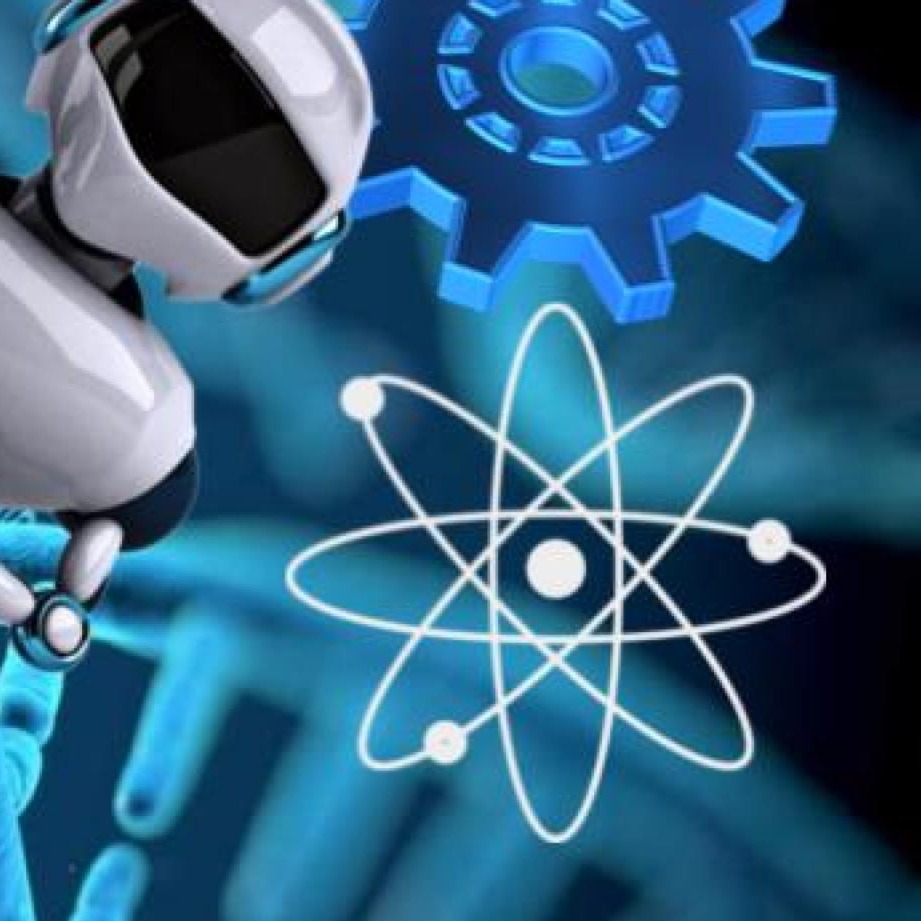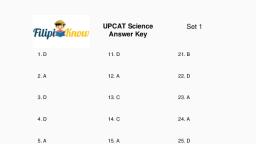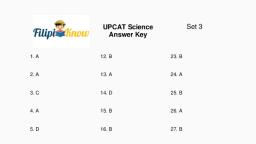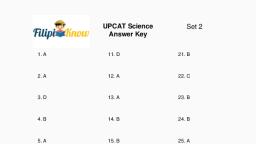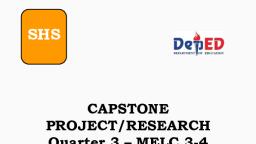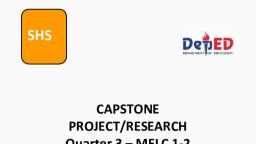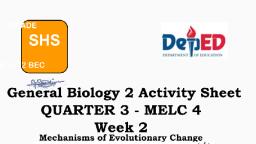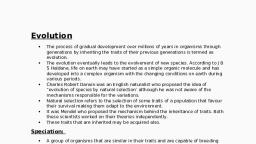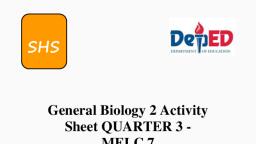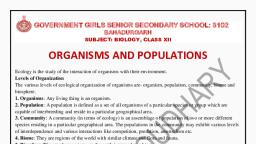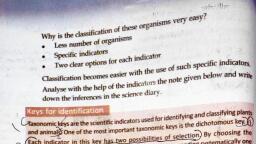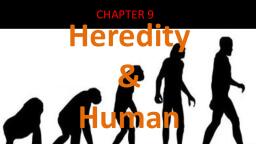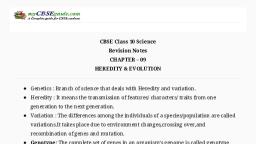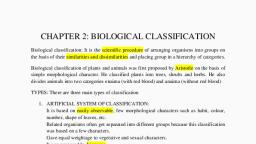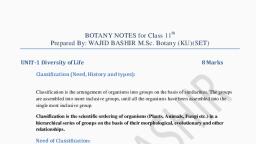Page 1 :
SHS, , General Biology 2, Activity Sheet, Quarter 3 – MELC 8, Week 4, Evolutionary Relationships, Among Organisms, , REGION VI – WESTERN VISAYAS
Page 2 :
General Biology 2, Activity Sheet No. 8 - Evolutionary Relationships Among Organisms, First Edition, 2021, Published in the Philippines, By the Department of Education, Region 6 – Western Visayas, Republic Act 8293, section 176 states that: No copyright shall subsist in any work of, the Government of the Philippines. However, prior approval of the government agency or office, wherein the work is created shall be necessary for exploitation of such work for profit. Such, agency or office may, among other things, impose as a condition the payment of royalties., This Learning Activity Sheet is developed by DepEd Region 6 – Western Visayas., ALL RIGHTS RESERVED. No part of this learning resource may be reproduced or, transmitted in any form or by any means electronic or mechanical without written permission, from the DepEd Regional Office 6 – Western Visayas., Development Team of Activity Sheet, , Writer:, , DOREN L. MAGDAMO, , Content and Language Editing:, MARY CHERRY LYNN M. DALIPE, Division of Aklan Management Team:, Dr. MIGUEL MAC D. APOSIN, CESOV, Mr. SAMUEL J. MALAYO, Dr. DOBIE P. PAROHINOG, Dr. MARY CHERRY LYNN M. DALIPE, Mr. MAHNNIE Q. TOLENTINO, Regional Management Team, RAMIR B. UYTICO, PEDRO T. ESCOBARTE, JR., ELENA P. GONZAGA, DONALD T. GENINE, ROVEL R. SALCEDO, MOONYEEN C. RIVERA, ANITA S. GUBALANE, MINDA L. SOLDEVILLA, DAISY L. LOPEZ, JOSEPH M. PAGALARAN
Page 3 :
Introductory Message, Welcome to General Biology 2!, The Learning Activity Sheet is a product of the collaborative efforts of the Schools, Division of Aklan and DepEd Regional Office VI - Western Visayas through the Curriculum, and Learning Management Division (CLMD). This is developed to guide the learning, facilitators (teachers, parents and responsible adults) in helping the learners meet the, standards set by the K to 12 Basic Education Curriculum., The Learning Activity Sheet is self-directed instructional materials aimed to guide, the learners in accomplishing activities at their own pace and time using the contextualized, resources in the community. This will also assist the learners in acquiring the lifelong, learning skills, knowledge and attitudes for productivity and employment., , For learning facilitator:, The General Biology 2 Activity Sheet will help you facilitate the leaching- learning activities, specified in each Most Essential Learning Competency (MELC) with minimal or no face-to-face, encounter between you and learner. This will be made available to the learners with the, references/links to ease the independent learning., , For the learner:, The General Biology 2 Activity Sheet is developed to help you continue learning even if you, are not in school. This learning material provides you with meaningful and engaging activities for, independent learning. Being an active learner, carefully read and understand the instructions then, perform the activities and answer the assessments. This will be returned to your facilitator on the, agreed schedule.
Page 4 :
Name of Learner:, Grade and Section:, , Date:, , General Biology 2 ACTIVITY SHEET No. 8, Evolutionary Relationships Among Organisms, , I. Learning Competency, Infer evolutionary relationships among organisms using the evidences of, evolution. (STEM_BIO11/12-IIIc-g-13), II. Background Information for Learners, In 1859, Charles Darwin published his book, On the Origin of Species by, Means of Natural Selection. Contrary to creationism, Darwin believed that organisms, evolve from a common ancestor. Having a common ancestor, you are all related to, one another no matter how different you are. The relationships among organisms, can be illustrated on a family tree as shown in the illustration below., , Figure 1- Family Tree of Life, Photo Source: www.sirinet.net/-jgjohso/tree.html
Page 5 :
Living organisms sit like leaves at the tips of the branches of the Tree of Life., Living things share a common ancestor. All organisms are related to one another no, matter how different they seem. Scientists collect information that allows them to, make evolutionary connections between organisms. Similar to detective work,, scientists must use evidence to uncover the facts. In the case of phylogeny,, evolutionary investigations focus on two types of evidence: morphologic (form and, function) and genetic., Two Measures of Similarity, Organisms that share similar physical features, and genetic sequences tend to be more closely, related than those that do not. Features that, overlap both morphologically and genetically are, referred to as homologous structures; the, similarities stem from common evolutionary, paths. As shown in Figure 2, the bones in the, wings of bats and birds, the arms of humans, and, the foreleg of a horse are homologous, structures. Notice the structure is not simply a, single bone, but rather a grouping of several, bones arranged in a similar way in each, organism even though the elements of the, structure may have changed shape and size., Misleading Appearances, Figure2., , Organisms with homologous, structures, , Some organisms may be very, closely related, even though a, minor genetic change caused a, major morphological difference to, make them look quite different., For example, chimpanzees and, humans, the skulls of which are, shown in Figure 3 are very similar, genetically,, sharing, 99, percent of their genes. However,, chimpanzees and humans show, considerable, anatomical, Figure 3, (a) The chimpanzee jaw protrudes to a much greater degree than, differences,, (b) the human jaw., including the degree to which the, Photo Source: modification of work by "Pastorius"/Wikimedia Commons, jaw protrudes in the adult and the, relative lengths of our arms and, legs. However,, unrelated organisms may be distantly related yet appear very much alike, usually, because common adaptations to similar environmental conditions evolved in both., An example is the streamlined body shapes, the shapes of
Page 6 :
fins and appendages, and the shape of the tails in fishes and whales, which are, mammals. These structures bear superficial similarity because they are adaptations, to moving and maneuvering in the same environment—water. When a characteristic, that is similar occurs by adaptive convergence (convergent evolution), and not, because of a close evolutionary relationship, it is called an analogous structure. In, another example, insects use wings to fly like bats and birds. We call them both, wings because they perform the same function and have a superficially similar form,, but the embryonic origin of the two wings is completely different. The difference in the, development, or embryogenesis, of the wings in each case is a signal that insects, and bats or birds do not share a common ancestor that had a wing. The wing, structures, shown in Figure 3 evolved independently in the two lineages., Similar traits can be either homologous or analogous. Homologous traits share an, evolutionary path that led to the development of that trait, and analogous traits do, not. Scientists must determine which type of similarity a feature exhibits to decipher, the phylogeny of the organisms being studied., Molecular Comparisons, With the advancement of DNA technology, the area of molecular systematics, which, describes the use of information on the molecular level including DNA sequencing,, has blossomed. New analysis of molecular characters not only confirms many earlier, classifications, but also uncovers previously made errors. Molecular characters can, include differences in the amino-acid sequence of a protein, differences in the, individual nucleotide sequence of a gene, or differences in the arrangements of, genes. Phylogenies based on molecular characters assume that the more similar the, sequences are in two organisms, the more closely related they are. Different genes, change evolutionarily at different rates and this affects the level at which they are, useful at identifying relationships. Rapidly evolving sequences are useful for, determining the relationships among closely related species. More slowly evolving, sequences are useful for determining the relationships between distantly related, species. To determine the relationships between very different species such as, Eukarya and Archaea, the genes used must be very ancient, slowly evolving genes, that are present in both groups, such as the genes for ribosomal RNA. Comparing, phylogenetic trees using different sequences and finding them similar helps to build, confidence in the inferred relationships., Building Phylogenetic Trees, How do scientists construct phylogenetic trees? Presently, the most accepted, method for constructing phylogenetic trees is a method called cladistics. This method, sorts organisms into clades, groups of organisms that are most closely related to each, other and the ancestor from which they descended. For example, in Figure 4, all of, the organisms in the shaded region evolved from a single ancestor that had amniotic, eggs. Consequently, all of these organisms also have amniotic eggs and make a, single clade, also called a monophyletic group. Clades must include the ancestral, species and all of the descendants from a branch point.
Page 7 :
Clades can vary in size depending on which branch point is being referenced. The, important factor is that all of the organisms in the clade or monophyletic group stem, from a single point on the tree. This can be remembered because monophyletic, breaks down into “mono,” meaning one, and “phyletic,” meaning evolutionary, relationship., , Shared Characteristics, Organisms evolve from common ancestors and then diversify. Scientists use, the phrase “descent with modification” because even though related organisms have, many of the same characteristics and genetic codes, changes occur. This pattern, repeats over and over as one goes through the phylogenetic tree of life:, 1. A change in the genetic makeup of an organism leads to a new trait which, becomes prevalent in the group., 2. Many organisms descend from this point and have this trait., 3. New variations continue to arise; some are adaptive and persist, leading to new, traits., 4. With new traits, a new branch point is determined (go back to step 1 and repeat)., If a characteristic is found in the ancestor of a group, it is considered a shared, ancestral character because all of the organisms in the taxon or clade have that, trait. The vertebrate is a shared ancestral character. Now consider the amniotic egg, characteristic in the same figure. Only some of the organisms have this trait, and to, those that do, it is called a shared derived character because this trait derived at, some point but does not include all of the ancestors in the tree., The tricky aspect to shared ancestral and shared derived characters is the fact that, these terms are relative. The same trait can be considered one or the other depending, on the particular diagram being used. Note that the amniotic egg is a shared ancestral, character for the Amniota clade, while having hair is a shared derived character for, some organisms in this group. These terms help scientists distinguish between, clades in the building of phylogenetic trees.
Page 8 :
Choosing the Right Relationships, Imagine being the person responsible for organizing all of the items in a department, store properly—an overwhelming task. Organizing the evolutionary relationships of, all life on Earth proves much more difficult: scientists must span enormous blocks of, time and work with information from long-extinct organisms. Trying to decipher the, proper connections, especially given the presence of homologies and analogies,, makes the task of building an accurate tree of life extraordinarily difficult. Add to that, the advancement of DNA technology, which now provides large quantities of genetic, sequences to be used and analyzed. Taxonomy is a subjective discipline: many, organisms have more than one connection to each other, so each taxonomist will, decide the order of connections., To aid in the tremendous task of describing phylogenies accurately, scientists often, use a concept called maximum parsimony, which means that events occurred in, the simplest, most obvious way. For example, if a group of people entered a forest, preserve to go hiking, based on the principle of maximum parsimony, one could, predict that most of the people would hike on established trails rather than forge new, ones., For scientists deciphering evolutionary pathways, the same idea is used: the, pathway of evolution probably includes the fewest major events that coincide with the, evidence at hand. Starting with all of the homologous traits in a group of organisms,, scientists look for the most obvious and simple order of evolutionary events that led, to the occurrence of those traits., III. Activity Proper, Activity 1, Directions: Based on the information given above, answer the following questions., 1. Dolphins and fish have similar body shapes. Is this feature more likely a, homologous or analogous trait?, 2. Describe maximum parsimony., , 3. How does a biologist determine the polarity of a character change?, , 4. “In evolutionary relationships using the evidences of evolution, the more closely, related the species are, the more similar their DNA sequences.” Do you agree in, this statement or not? Briefly explain your answer.
Page 9 :
IV. Reflection, Complete the statements below., I understand, , I don’t understand, , I need more information about
